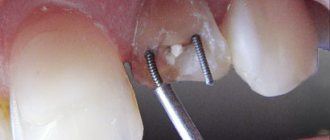Pathological changes in the oral cavity, as well as diseases of the oral mucosa are one of the symptoms of the presence of the immunodeficiency virus in the body. However, one should not think that the presence of dental problems may indicate infection with the immunodeficiency virus. To understand how oral diseases are related to HIV infection, it is worth talking in more detail about the immunodeficiency virus and its vital functions.
What is HIV? What is HIV infection
The human immunodeficiency virus, or HIV, was identified and described relatively recently. Invading the human body, it primarily affects macrophage cells and T-lymphocytes, which are responsible for recognizing and destroying hostile bacteria. Thus, the body's immune barrier loses its ability to resist both external bacterial attacks and internal opportunistic flora.
The immunodeficiency virus is transmitted exclusively through sexual contact or through direct contact of a healthy body with infected blood. Transmission of the virus through household or food contact is impossible.
HIV infection is a slow-onset disease caused by a virus and occurs against a background of suppressed immunity. It can take years from the introduction of the virus to the clinical manifestations of the disease. During this entire period, the virus does not manifest itself in any way, and its presence can only be diagnosed using a laboratory method.
FIVE MYTHS ABOUT WARTS
Dermatovenerologist, infectious disease specialist Svetlana Valentinovna Kuklina, a doctor of the highest category, tells the story.
People are often confused about such a pressing problem as warts. Often, skin manifestations push people to undergo improper treatment, which can be harmful to health and beauty. Here are five common myths about warts that affect your health, and even your life.
Myth 1. Warts are exclusively a skin disease. Most people believe that all skin manifestations, including warts, signal exclusively skin diseases. However, it is not. The wart is just the tip of the iceberg. But the problem itself, the danger, lies within a person. Let's look at it with an example. If you take a good-looking apple, but with a small wormhole, then breaking it in half, you will see that it is infested with a large number of worms. Roughly the same thing happens in humans. When the immune system is weakened, the human papillomavirus resides in the basal cells of the body's skin. And this manifests itself on the skin as just such a small problem, seemingly not so significant.
There are several types of human papillomaviruses (HPV), which may or may not cause cancer. Many people are carriers of this virus. If immunity is normal, then the presence of HPV is simply not noticeable to our body. However, if the body is weakened, the virus hijacks a human cell and begins to develop and multiply in it.
Myth 2. Warts and papillomas are the same thing. Warts and papillomas are caused by the same virus, HPV, but by different types. Accordingly, they may differ, for example, in the places where tissue growths that this virus causes appear. Some go away without a trace, without treatment, while others, on the contrary, require mandatory removal. There are benign and there are malignant skin manifestations of HPV, which can lead to serious consequences. So, what do papillomas and warts look like?
Wart If we talk about warts, they are usually round or cone-shaped and quite dense to the touch. Most often flesh-colored. May be yellowish or slightly brownish. The diameter can be up to ten millimeters. Although it can be more than a centimeter. The top of the wart is dry and has a so-called root. A typical location is the hands and feet. There are also flat warts or juvenile warts. They often appear on the face and mainly affect young children and adolescents, which is why they are called that. There are plantar warts, located on the sole of the foot, which are often confused with corns. Of all formations, a wart is the most benign.
Papilloma Characteristic features of papilloma are the presence of a stalk and the absence of a root. The diameter of papillomas is generally five to ten millimeters. But there is more. Papillomas are often flesh-colored, but can also be dirty brown. Typical places for papillomas to appear are the face, neck, armpits and other natural folds. Papilloma is also found on the cervix. And if warts do not require mandatory treatment and can go away on their own, then papillomas do not go away on their own. In addition, they can grow and become malignant, especially if they are regularly injured, for example, by clothing or jewelry.
Genital condylomas Even more dangerous are formations that are pink or bluish in color. Externally similar to a cockscomb. They have no root and do not adhere tightly to the skin. A characteristic feature of genital warts is sexual transmission. They are often located on the genitals, as well as mucous membranes, including the mucous membranes of the mouth, conjunctiva and genitourinary organs. Sometimes in patients, genital warts may not appear on the external genitalia, but can be found in the vagina, on the cervix and cause dysplasia. The main cause of cervical cancer is the human papillomavirus of high oncogenic risk.
When skin manifestations occur, laboratory tests should be performed. Most often, a Papanicolaou smear (PAP test) is prescribed, and analysis is carried out using the polymerase chain reaction (PCR) method. Sometimes a histological examination of tissue samples obtained by biopsy and determination of antibodies is carried out. If genital warts appear, you should seek help from a dermatovenerologist. They usually also consult with an immunologist.
Myth 3. Infection with a virus through a handshake. If you shake hands or touch the hand of a person who has a wart, it is almost impossible to become infected with it. If the skin of a healthy person is not damaged, the risk of transmission of the virus from an infected person is zero. Moreover, if a sick person has a damaged wart, and a healthy person has any damage to the skin, then in this case, upon contact, viral particles may well be transmitted from the sick person to the healthy person.
Infection often occurs when sharing personal hygiene items, such as towels, manicure accessories, washcloths, etc.
Myth 4. You can cure a wart on your own. Why shouldn't you self-medicate? Firstly, you cannot be sure exactly what kind of problem has appeared on the skin: a wart or a papilloma. Secondly, self-medication can be harmful to health and also ruin your appearance. Independent actions can cause a burn, a scar, which will still have to be treated later. Do not use acidic compounds. Acid-based products are usually transparent, so the area and depth of their effect is not visible. As a result, you can get a severe burn that will take a long time to heal. Subsequently, the burn will turn into a scar, which is not very aesthetically pleasing.
It is highly not recommended to pull papillomas to remove them. When bandaged, the upper part of the papilloma dies and falls off. But the human papillomavirus, again, remains in the skin layers, and the papilloma will grow again. In addition, this can spread the infection even further.
Myth 5. A wart can be removed once and for all. When a wart is removed, only its external manifestations disappear. But the virus itself is not destroyed. In the future, you need to work with the immune system. According to statistics, within two to three years, in eighty to ninety percent of cases, the virus is eliminated from the body. Sometimes elimination is possible against the background of self-healing. But more often, the treatment of warts requires the joint participation of dermatologists, immunologists, and gynecologists in the process.
Removal of such skin manifestations in cosmetology or medical institutions is carried out using cryodestruction, laser coagulation, and electrocoagulation. Liquid nitrogen or the action of heat causes controlled necrosis of the skin, the formation itself, and, accordingly, the growth is removed.
Prevention measures. It is important that the skin is protected from cuts and damage. Otherwise, you need to treat the damaged area and cover it with an adhesive plaster. At this time, visiting public places such as bathhouses, saunas, and swimming pools is not recommended. As for genital warts, you need to use condoms to minimize the risk of such unwanted manifestations. For prevention, it is important to maintain a normal immune system. To do this, you need to rest properly, eat right, consume enough protein and vitamins to replace and restore immune cells.
Make an appointment with a dermatologist-venereologist by phone +7 (8332) 497-003 or leave a request for a free call
In addition, you can take advantage of the opportunity to make an electronic appointment with a doctor
Save
HIV infection of the oral cavity and its causes
Inflammatory processes in the mucous tissues of the oral cavity are one of the first symptoms of virus activation. This is due to the peculiarity of the structure of the oral cavity and its constant contact with the aggressive external environment. Most often, the mucous membrane is affected by the herpes simplex virus, Candida fungus, Epstein-Barr virus, and papillomaviruses. Bacterial infections are caused by streptococci and staphylococci, which are no longer contained by local immunity. In conditions of immunity suppressed by the virus, periods of remission become shorter, and inflammatory processes are acutely progressive. Timely prescribed additional studies make it possible to correctly prescribe a course of maintenance therapy, since diseases of the oral mucosa are not directly a symptom of HIV infection.
Based on their suspected association with HIV, oral infections are divided into three groups.
Group 1 includes pathologies most closely associated with the immunodeficiency virus:
- candidiasis, colloquially “thrush”;
- hairy leukoplakia (changes in the mucous membrane of the tongue);
- HIV gingivitis (acute inflammation of the gums);
- HIV periodontitis (periodontal inflammation);
- Kaposi's sarcoma (a specific neoplasm on the hard palate of the oral cavity);
- non-Hodgkin's lymphoma.
The 2nd group of diseases includes lesions to a lesser extent, associated with symptoms of HIV infection:
- thrombocytopenic purpura (multiple hemorrhages);
- pathology of the salivary glands;
- viral infections (herpes).
Group 3 includes diseases that often occur with HIV infection, but are not associated with it. Below we will consider diseases from the first group, as the most characteristic of the state of immunodeficiency.
Symptoms of HIV infection in the oral cavity
The herpes simplex virus is present in most people. The infection persists in the body throughout life and does not cause any special problems, except for rare rashes on the lips.
Herpetic gingivostomatitis
In HIV-infected people, herpes rashes are chronic with rare stages of remission. It is distinguished by blistering rashes around the mouth and on mucous tissues. When the vesicles open, painful erosions occur that develop into fairly large ulcers. The manifestation of herpes zoster and rashes in atypical places is also noticed.
Candidiasis
Candidiasis is also a common symptom of HIV infection and is chronic. Its symptoms are the same as with regular thrush, the only difference being that plaque covers most of the mouth.
Hairy leukoplakia
Clinical manifestations of the disease look like deformed mucous tissue, externally resembling folds or hairs. Localization area: lateral parts of the tongue and the inner surface of the cheeks. Painful sensations are usually absent.
HIV gingivitis and periodontitis
In this case, the infection manifests itself as acute inflammation of the gums. Starting with ordinary bleeding gums, the disease quickly develops into an acute form. With adequate treatment, tooth loss can be avoided.
Kaposi's sarcoma
This is one of the most characteristic symptoms of HIV infection in the clinical stage of manifestation. The tumor is formed from lymphatic vessels, in the mouth it is located near the root of the tongue, less often on the gums.
Diagnosis for suspected HIV infection
For differentiated diagnosis of HIV infection from similar dental diseases, the following tests are used:
- Blood test for PCR reaction (aimed at detecting HIV).
- Immunoblotting technique.
- Linked immunosorbent assay.
- Checking immune status.
If the results are unclear, additional blood tests, as well as bacteriological studies, may be prescribed. Early diagnosis of the root cause of diseases can significantly alleviate the course of the disease.
Main stages of the disease
The stages of HIV are divided into the following:
- incubation This is the stage at which infection and subsequent multiplication of the virus in the blood occurs. It lasts up to six weeks, sometimes less. Even if infected, at this stage a person will not see obvious signs, and a blood test will not show that there are antibodies in the blood;
- primary. The first signs of infection may already appear here. The second stage lasts for 3 weeks - at this time antibodies appear, the virus is determined in the laboratory;
- subclinical. The first sign of the disease appears - enlarged lymph nodes. The patient feels completely healthy and does not complain about his health;
- the appearance of secondary diseases. The immune system begins to malfunction, causing a variety of diseases to appear: from frequent colds and candidiasis to pneumonia, tuberculosis;
- terminal. The stage involves exhaustion (rather rapid and progressive), as well as the subsequent death of the patient.
The stages do not have one correct time frame - they may differ from person to person. For example, HIV-infected people often feel well for years or do not pay attention to small signs. The disease is detected only at the stage of severe deterioration in health or through random tests.








